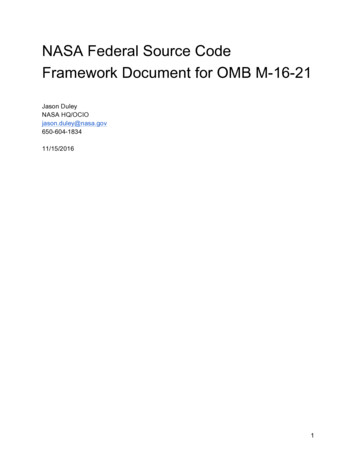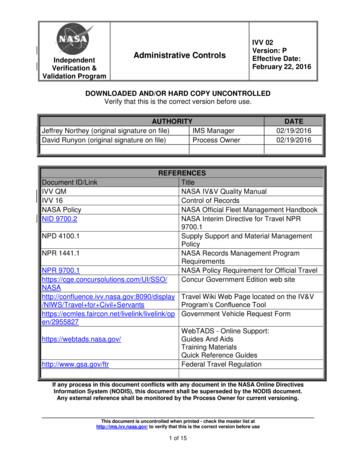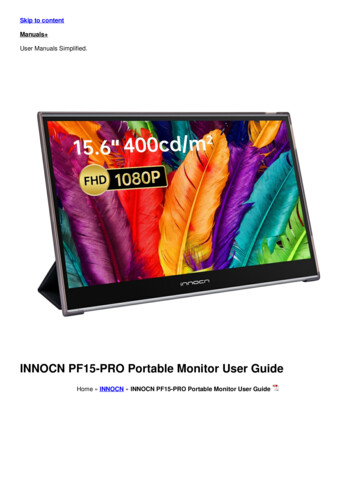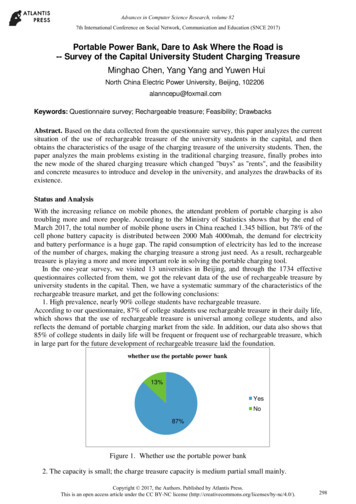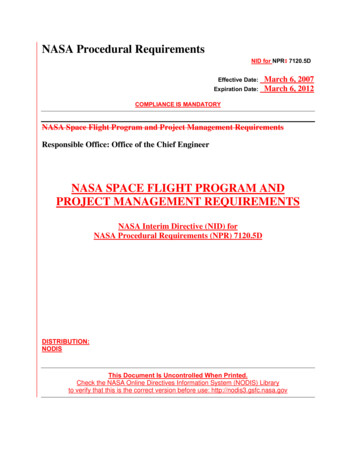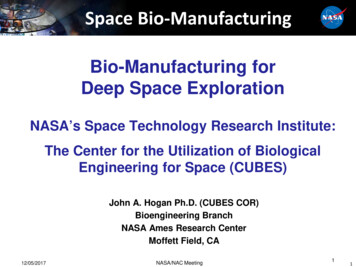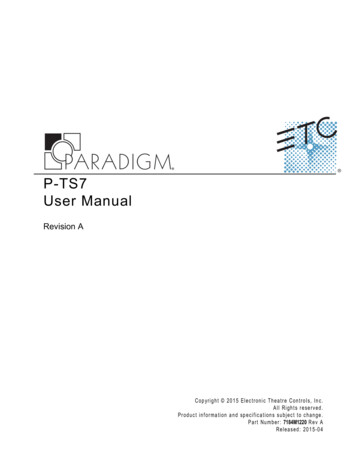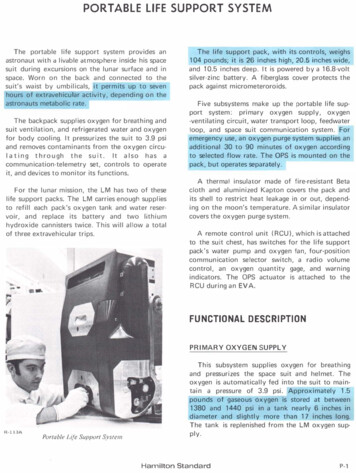
Transcription
PORTABLE LIFE SUPPORT SYSTEMThe portable life support system provides anastronaut with a livable atmosphere inside his spacesuit during excursions on the lunar surface and inspace. Worn on the back and connected to thesuit's waist by umbilicals, it permits up to sevenhours of extravehicular activity, depending on theastronauts metabolic rate.The backpack supplies oxygen for breathing andsuit ventilation, and refrigerated water and oxygenfor body cooling. It pressurizes the suit to 3.9 psiand removes contaminants from the oxygen circu l a t i n g t hr o u gh t h e s u i t . It a l s o h a s acommunication-telemetry set, controls to operateit, and devices to monitor its functions.For the lunar mission, the LM has two of theseIife support packs. The LM carries enough sup pi iesto refill each pack's oxygen tank and water reser voir, and replace its battery and two lithiumhydroxide cannisters twice. This will allow a totalof three extravehicular trips.The life support pack, with its controls, weighs104 pounds; it is 26 inches high, 20.5 inches wide,and 10.5 inches deep. It is powered by a 16.8-voltsilver-zinc battery. A fiberglass cover protects thepack against micrometeroroids.Five subsystems make up the portable life sup port system: primary oxygen supply, oxygen-ventilating circuit, water transport loop, feedwaterloop, and space suit communication system. Foremergency use, an oxygen purge system supplies anadditional 30 to 90 minutes of oxygen accordingto selected flow rate. The OPS is mounted on thepack, but operates separately.A thermal insulator made of fire-resistant Betacloth and aluminized Kapton covers the pack andits shell to restrict heat leakage in or out, depend ing on the moon's temperature. A similar insulatorcovers the oxygen purge system.A remote control unit ( RCU), which is attachedto the suit chest, has switches for the life supportpack's water pump and oxygen fan, four-positioncommunication selector switch, a radio volumecontrol, an oxygen quantity gage, and warningindicators. The OPS actuator is attached to theRCU during an EVA.FUNCTIONAL DESCRIPTIONPR IMAR Y OXYGEN SUPPLYR·ll3APortable Life Support SystemThis subsystem supplies oxygen for breathingand pressurizes the space suit and helmet. Theoxygen is automatically fed into the suit to main tain a pressure of 3.9 psi. Approximately 1.5pounds of gaseous oxygen is stored at between1380 and 1440 psi in a tank nearly 6 inches indiameter and slightly more than 17 inches long.The tank is replenished from the LM oxygen sup ply.Hamilton StandardP-1
OXYGEN-VENTILATING CIRCUITExcess water entering the oxygen flow, mainlyfrom astronaut respiration and perspiration, isremoved by a water separator and stored outsideThis subsystem circulates oxygen through thespace-suit pressure garment and purifies recircu lating oxygen. It also helps cool the astronaut byevaporating moisture that accumulates on his skin.the bladder section of the water reservoir. A fanrecirculates oxygen to the space suit at a rate of5.5 cubic feet per minute.Oxygen entering the backpack from the suitSixpasses through a lithium hydroxide cartridge,where chemicals trap carbon dioxide exhaled bythe astronaut. It then goes through an activated charcoal bed that removes trace contaminants,including body odors. The oxygen flow is cooledby a porous-plate sublimator, a self-regulating heat rejection device developed by Hamilton Standard.Water in the sublimator absorbs the heat and seepst h r o u gh t h e p o r e s o f t h e s u blim a t o r'ss i n t e r e d-nickel plates which are exposed tovacuum. The water freezes, forms an ice layeracross the plates, then turns from ice to vapor. Therate of this sublimating process is governed by theamount of heat being rejected.1 OXYGEN\.hydroxidecartridgesareThis loop cools the astronaut by removing hismetabolic heat and any heat that leaks into the suitfrom the hot lunar surface. A battery-operatedpump continuously circulates 1.35 pounds ofchilled water at a rate of 4 pounds per minutethrough a network of plastic tubing integrated inthe liquid cooling garment worn under the spacesuit. The pack dissipates metabolic heat at anaverage of 1,600 Btu per hour and can handle peakrates up to 2,000 Btu.JZ:::::) HIGHPRESSURE OXYGENlliiiliiD LOW PRESSURE OXYGEN8: WATERc:::T:::J R A NSPORT WATER1ZZZJ FEEOWATERmiZ!ia RESERVOIRVENT ELECTRICAL CABLE'-'!ANUAL SHUT"fPRESSURE REGULATORQ80 PRESSURE SENSORCD TEMPERATURE SENSOR[L] FLOW SENSOR'CJ:: RELIEF VALVE OXYGEN AND WI\TER LINEilithiumWATER TR ANSPOR T LOOPOXYGEN PURGE SYSTEM,-----IIIIIIIIIIextracarried in the LM to replace used cartridges.0G-CHECK VALVECHECK VALVE WITHDISCONNECT RELEASEOFF VALVEREGUI-t-----1IIIIIIIIILH20SHUTOFFI ANDRELIEFI VALVETHERMAL METEOROIDGARMENTR·ll4AApollo Extravehicular Mobility Unit Schematic -Lunar ConfigurationP-2Hamilton Standard
R-115AFront ViewR-116Aof PLSSThe sublimator that cools the oxygen flowextracts heat from the circulating water, whichnormally leaves the pack at 45 F To controlcooling, the astronaut uses a valve on the pack toselect any one of three water temperature ranges(45 to 50 , 60 to 65 , or 75 to 80 ) This valvediverts water past the sublimator.FEEDWATER LOOPThis subsystem supplies 11.8 pounds of expend able water, stored in a rubber bladder reservoir, tothe heat-rejecting porous-plate sublimator. Of thisexpendable feedwater, 8-5 pounds is stored in themain reservoir; an auxiliary tank holds the remain ing 3.3 pounds. Suit pressure against the bladderforces water into passages between the sublimator'sheat transport fluid passages and its metal plates,which are exposed to space vacuum. The ice layerformed on the porous plates during sublimationprevents the slightly pressurized water from flow ing through the metal pores.Condensed water from the oxygen-ventilatingcircuit is collected outside the reservoir bladder.Feedwater is replenished from the LM supply.Rear View of PLSSRefilling the bladder forces water condensed fromthe oxygen flow into the LM waste managementsystem.SPACE SUIT COM M UNICATION SYSTEMThis system, manufactured by Radio Corpora tion of America, provides primary and backup dualvoice transmission and reception, telemetry trans mission of physiological and backpack perform ance data, and an audible warning signal. It alsoregulates the voltage and electrical current of theoxygen quantity gauge and various sensors.Operation of the communication system in thedual mode, provides crew members with uninter rupted duplex voice communications with oneanother, with the LM and, via the LM, withMission Control. A dual volume control permitsadjustment of receiver sound level. The transceivercontrol station on the LM is used as a relay stationbetween crewmen on the lunar surface or in space.It also relays radio-telemetry data to earth moni tors and to the Command M odule when it is inline-of-sight of the LM.Hamilton StandardP-3
Telemetry information is transmitted withoutThe purge unit weighs 35.1 pounds; is 18.4interrupting or interfering with voice communica inches long, 10 inches high, and 8 inches deep.tion. Nine telemetry channels transmitted to theTwoLM carry suit operational and environmental data pounds of oxygen stored at 6,950 psi. A battery oxygen supply pressure, suit water inlet tempera powered,ture, sublimator oxygen outlet temperature, suitthe rapidly expanding oxygen to prevent subzeropressure, feedwater pressure, suit water tempera oxygen temperatures at the space-suit flow inlet.spherical containers hold atemperature- controlledtotalof5.7heater warmsture rise, C02 partial pressure, and backpack bat tery current and voltage. A tenth channel transmitsan electrocardiogram signal.Indicators mounted on the remote control unitprovide the astronaut with a visual warning of highoxygen usage rate, low suit pressure, low ventila tion flow and low feedwater pressure. An audibletone sounds to alert the astronaut that an abnor mal condition exists. Flags trip into view in theindicator windows, identifying the problem so thatthe astronaut can take corrective action.OXYGENPURGE SYSTEMThe oxygen purge system OPS, connected to thesuit by a separate umbilical, is designed for backupuse in the event of emergencies such as loss of suitOxygen Purge Systempressure or depleted oxygen supply. However, anastronaut can use it independently as a life supportchest pack during extravehicular transfer betweenBUDDY SECONDARY L1 FE SUPPORT SYSTEMthe LM and CM spacecraft.The system supplies either an open-loop purgeflow or makeup flow directly to the suit. In bothcases, it maintains suit pressure at 3.7 psi. In thefull purge mode, it provides a 30-minute flow at arate of 8.3 pounds of oxygen an hour, fulfillingThe buddy system consists of two flexible hoseswhich feed cooling water from one astronaut's lifesupport backpack to the other space suit if its cool ing equipment fails.Addition of the buddy system doubles the timebreathing and cooling requirements, flushing outthe emergency oxygen available in the OPS cancarbon dioxide, and defogging the helmet visor.last. The oxygen purge system support pack previ ously supplied oxygen not only for breathing pur Whenusedin conjunction with theBuddySecondary Life Support System (BSLSS), the OPSposes and pressurizing the suit but to cool theastronaut by its high flow rate.flow is reduced to 4.2 pounds per hour, which per mits emergency operation for up to 75 minutes.With the buddy system taking over the coolingfunction, emergency oxygen flow can be slowedThe OPS, mounted separately on top of thedown to extend its supply from 30 minutes to 60backpack, is operated by a lever, attached to theto 90 minutes. The length of time is governed bypack'sthe level of the astronaut's physical activity.remotecontrolunit.Itsumbilicalisattached to the suit connector that connects thesuit to the LM Environmental Control Subsystemwhen the astronaut is inside the LM.P-4The emergency water-cooling hoses are eight anda half feet long. One hose carries water into theHamilton Standard
suit, the other out of it. A six-foot tether on theIn event of an emergency, the astronauts willhoses snaps on the space suits and prevents theremove the buddy system from the stowage pouchhoses from reaching their full length when they areand hook the tether to the waist-restraint rings onconnected, protecting the hoses and space suitstheir space suits. The astronaut whose life supportagainst possible damage during the walk back topack cooling system has failed will disconnect thethe LM. Water and tether lines are stowed in apack water hose. Assisting each other, the astro pouch which is carried on the PLSS or Lunarnauts then will plug the buddy system water cooling hoses into multiple connectors which joinRover during each EVA.the life support backpack's water lines to the eLifeSupport System was provided by Hamilton Standard, Division ofUnited Aircraft.Complete details on the Portable Life SupportSystem can be obtained from Hamilton Standard.Hamilton StandardP-5
port system: primary oxygen supply, oxygen -ventilating circuit, water transport loop, feedwater loop, and space suit communication system. For emergency use, an oxygen purge system supplies an additional 30 to 90 minutes of oxygen according to selected flow rate.
